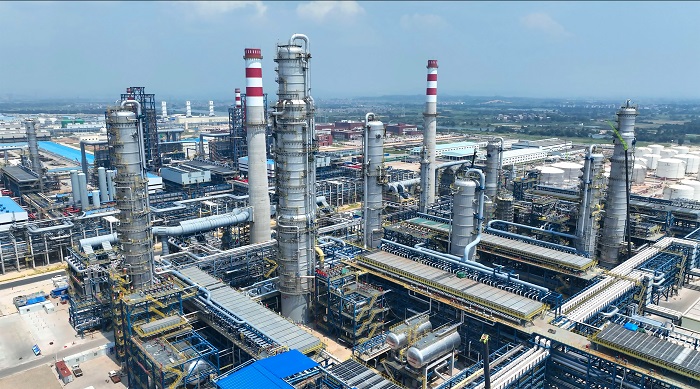The output of aromatics of Guangdong Petrochemical Company has exceeded 2.55 million tons
By 6:00 on December 31st, the 2.6 million tons/year aromatics complex of Guangdong Petrochemical Company had produced a total of 2.5552 million tons of para-xylene and 738,500 tons of pure benzene throughout the year. The aromatics output has reached 3.3 million tons/year, reaching the best level since the unit was put into operation.

The 2.6 million tons/year aromatics complex of this company is currently the largest single production capacity unit in the world and accounts for half of the aromatics production capacity of petrochina. After the full entry of production and operation into the production sequence in 2024, during the process of increasing the load of the facility, due to changes in processing volume and raw material composition, the high-load bottleneck problem gradually emerged, which once led to fluctuations in the production of the facility, the rotary valve not stepping in step, and the purity of the product repeatedly touching the lower limit.
To maximize the scale and cost advantages of the aromatics complex, the company, guided by the market, adheres to the principle of "oil where appropriate, aromatics where appropriate, and alkenes where appropriate", and has carried out a series of work such as lean management of the unit, tackling the production capacity of aromatics, solving long-term technical problems, and improving quality and efficiency.
The Fourth Refining Department of the company has raised the catalyst cycle rate of two continuous reforming units from 65% to 80%, increased the aromatic hydrocarbon content in the de-pentane oil from 82.5% to 89.69%, controlled the purity of para-xylene above 99.75%, and achieved a single-pass yield of over 97%.
In the process of constantly adjusting the load and raw materials, through multiple measures such as controlling the usage of fuel gas and medium and high-pressure steam from the source, improving the thermal efficiency of the heating furnace, and reducing process losses, the naphtha hydrogenation unit and the continuous reforming unit I&II can reduce the annual usage of nearly 1.2 million tetravalories of natural gas and about 170,000 tons of 1.3 megapascals of steam. In 2024, the average energy consumption of the aromatics complex was 165.32 kilograms of standard oil per ton of para-xylene, and the total energy consumption throughout the entire process was 308.25 kilograms of standard oil per ton of para-xylene, placing it at the "leader" in the industry.
Only when the equipment achieves a long cycle can the production threshold be broken through. Since the beginning of this year, Guangdong Petrochemical has been deeply engaged in the research and development of long-term operation of key and important equipment. In collaboration with the experts of the intelligent control system (IPC) Century Longbo Instrument, they have jointly analyzed and developed the "A8 Redistillation Tower and Reboiling Furnace Multi-variable dual-cascade Control" system. The automatic control rate of the device has reached 100%, and the stability rate has exceeded 99.88%.
The rotary valve system of the adsorption separation unit and the pumping control valve are the key points of capacity research and development. In response to the difficulties in stepping and insufficient extension of the No. 1 and No.2 rotary valves, in order to maintain production, the Fourth Refining Department has continuously reduced the top pressure of the No.2 rotary valve arch from 1.28 megapascals to 1.22 megapascals. The pressure of the main hydraulic oil supply pipe was gradually increased from 10.0 megapascals to 10.6 megapascals to enhance the driving force.
To increase production capacity, since 2024, the company plans that relevant functional departments such as the Business Department, Production and Operation Department, and Materials Procurement Department, as well as the Fourth Refining Department, will remain committed to the production target of 2.55 million tons of aromatics without wavering. They will collaborate with each other and pool their wisdom to solve problems and break through the deadlock. The Planning and Operation Department adjusted the feed volume of purchased mixed xylene by 300,000 tons based on the material balance of mixed xylene within the China National Petroleum Corporation system. The Fourth Refining Department has taken measures such as increasing the yield of para-xylene, continuously optimizing the load matching relationship of six units, and improving the conditions for disproportionation and isomerization reactions, resulting in a daily output of over 7,300 tons of para-xylene.
During the all-out efforts to increase the production capacity of para-xylene, the Party Committee of the Fourth Refining Department formed five Party member assault teams, including those for achieving the para-xylene production target and optimizing the production of the continuous reforming unit, as well as 11 assault teams, such as those for addressing the abnormal vibration of the P-2002 bottom pump of the product separation tank in the continuous reforming unit and reducing the circulating water consumption of the hydrogen recovery unit. Party members led the masses, took the initiative to act, and bravely overcame difficulties. This has enabled the smooth operation of the equipment and facilities, significantly reducing the number of alarms and unplanned shutdowns. It not only effectively promoted the in-depth integration of Party building and production but also achieved the goal of the aromatics production task.
